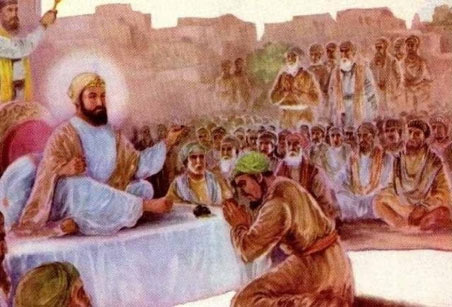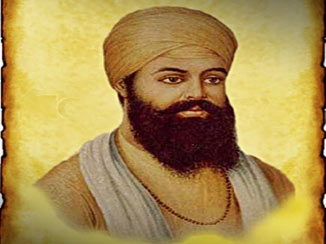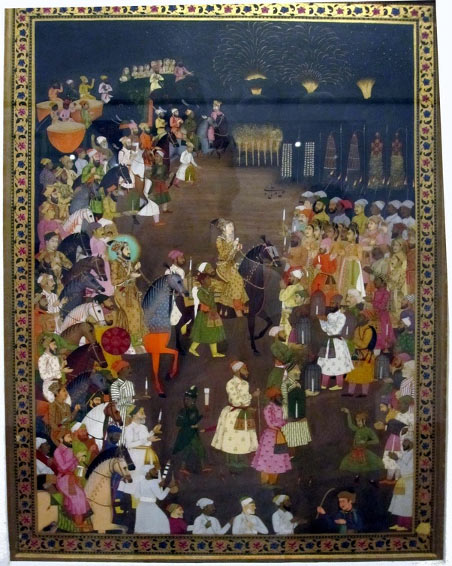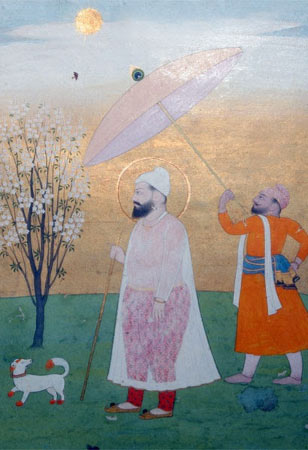GURU HAR RAI
Baba Vickram Aditya Bedi

Guru Baba Har Rai, giving medicine to the Shahi Hakim (Royal Physician), for Crown Prince Dara Shikoh. Circa 1650.
Guru Baba Har Rai is truly under- represented in Indian National History, as his years as the head of the Sikh Panth were the most crucial before India would fall victim to the barbarity of colonialism. Guru Har Rai, came from the Sodhi family of Punjab. He was the grandson of Guru Baba Hargobind who had been the sixth Guru of the Panth. He would become Guru at the age of 14 and from this point on he would inherit a religious movement which was expanding rapidly throughout India. He also would have control of a large land army within India. However in a remarkable management of the situation in India at that time, Guru Har Rai would not get involved in any military conflict throughout the term of his leadership. But, politically he had shown that the Panth would not simply back down, as Shah Jahan had given land grants and financial support to Guru Har Rai’s older brother. What was being attempted by Shah Jahan was to divide the Sikh Panth. This would not happen largely because of the actions of the young Guru Har Rai and his management of the Sikh Panth.

Guru Har Rai
Guru Har Rai not only was a dynamic leader, but he was able to create key friendships which truly exemplified what the Sikh movement represented at it’s core. Early on, the favored heir to the throne of Hindustan, Crown Prince Dara Shikoh, would develop a friendship with Guru Har Rai and it is here that one of the most unique chapters of Indian National History would take place. For here the Sikh Panth correctly chose the person who would have United India together in a rule of tolerance and equality. Dara Shikoh understood the principles of acceptance of religious differences as being nothing more than changes which one experiences in the change of seasons. For just as a year is united so is a nation, as the variations could not split from the whole. Dara Shikoh would translate great Indian Epics from Sanskrit to Persian so that they could be appreciated by the Royal court, for Dara Shikoh had a great interest in the Ancient Civilization of India.

Prince Dara Shikoh (Center)
When the struggle of succession was started by Dara Shikoh’s younger brother Aurangzeb in an out of line basis, as Shah Jahan had not passed away and his intention was to have Dara Shikoh take the throne and avoid another costly struggle of succession which by the late 1600’s were no longer viewed even in the Mughal Court as being feasible, as the revenues of Hindustan had now become the largest in the world. Dara Shikoh would be wounded in a battle with Aurengzeb, and seek refuge under the temporal throne of Baba Nanak. Here Dara Shikoh was allowed refuge, as Guru Har Rai would never allow any wounded person go without assistance. This was the second time that Guru Har Rai had saved Dara Shikoh. A decade earlier Aurangzeb had poisoned his brother, and at that time the only Ayurvedic cure for this poisoning was to be found in the Guru’s medical research facility. Shah Jahan, would send a now historical letter to ask for this help, which Guru Har Rai gave full authorization to provide. Guru Har Rai did not allow the fact that Shah Jahan had tried to divide the Sikh Panth stand in the way of curing his son.

Emperor Shah Jahan and Prince Dara Shikoh
When the war of succession ended, Aurangzeb would execute his own brother Dara Shikoh in front the latter’s young son. The cruelty shown to his own brother truly showed the inhumanity and jealously that Aurangzeb felt for him. For he had taken Dara Shikoh’s intellect, charisma and ability to form bonds with his fellow humans all as qualities which he did not possess himself and knew he never would. Aurangzeb was neither attractive in form nor in personality, his intellect was narrowly limited, however, these narrow unproductive areas he had an evil genius. Aurangzeb would attempt to take away from the legacy of Guru Har Rai, but when asked why he had assisted Dara Shikoh and entered the world of Indian politics, he simply stated “man breaks flowers with one hand and offers them with the other, but the flowers give perfume to both hands alike. The axe may cut the sandal tree, yet the sandal tree gives it scent to the Axe.”

Guru Har Rai
Guru Har Rai had established Ayurvedic Medical Research once more, and created a system of free hospitals. It was far beyond the ability of a man like Aurangzeb to judge the guru, nor inflict harm upon him. The legacy of Guru Har Rai is his humanity, his dedication to the Sikh Panth and his service to India at large. He established in a pre-modern India the idea that even animals needed to be offered medical treatment and would give them treatment in his hospitals. Guru Har Rai had supported Dara Shikoh, as had Shah Jahan,and, had the succession taken place according to their wishes, India would have been spared the indignity of colonialism and a United India would have remained into the present day.
References:
- Decade-long interchange with Guani Ji Manjeet Singh and Guani Ji Mukhtar Singh (former head of the Sikh Cultural Society of New York
- Bhagat Singh, Harbans Singh et al (eds): “Har Rai Guru (1630-1661 CE)”. Encyclopedia of Sikhism, Punjabi University, Patiala. Retrieved 16 January 2017
- William Owen Cole, Piara Singh Sambhi (1995): The Sikhs: Their Religious Beliefs and Practices. Sussex Academic Press. pp 33-34. ISBN 978-1-898723-13-4